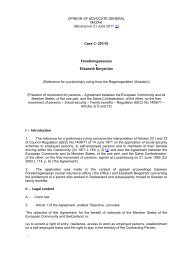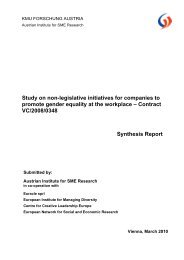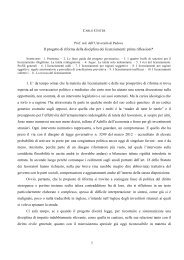Ethnic entrepreneurship: Concept paper - Eurofound - Europa
Ethnic entrepreneurship: Concept paper - Eurofound - Europa
Ethnic entrepreneurship: Concept paper - Eurofound - Europa
You also want an ePaper? Increase the reach of your titles
YUMPU automatically turns print PDFs into web optimized ePapers that Google loves.
<strong>Ethnic</strong> <strong>entrepreneurship</strong><br />
<strong>Concept</strong> <strong>paper</strong><br />
Click for contents<br />
Wyattville Road, Loughlinstown, Dublin 18, Ireland. - Tel: (+353 1) 204 31 00 - Fax: 282 42 09 / 282 64 56<br />
email: postmaster@eurofound.europa.eu - website: www.eurofound.europa.eu
Author: Jan Rath<br />
Research institute: Institute for Migration and <strong>Ethnic</strong> Studies (IMES) at the University of Amsterdam<br />
Research managers: Hubert Krieger and Anna Ludwinek<br />
Research project: Labour market mobility and access to social rights for migrants
Contents<br />
Introduction<br />
1. <strong>Concept</strong>ual issues and availability of data<br />
2. Analytical issues<br />
3. Mapping ethnic <strong>entrepreneurship</strong><br />
4. Local, national and EU policies to promote ethnic <strong>entrepreneurship</strong><br />
5. Conclusions<br />
References<br />
1<br />
5<br />
9<br />
13<br />
15<br />
22<br />
23
Introduction<br />
Many advanced economies, especially their larger cities, acquired a more cosmopolitan outlook in the closing decades<br />
of the 20th century and the opening decades of the 21st century. 1 This is reflected in an ever-broadening product range,<br />
which now includes not only obvious items such as Nokia mobile phones, McDonald’s hamburgers, Nike footwear and<br />
Levi’s jeans but also Chinese bubble tea, Turkish doner kebabs, Bollywood movies and Indian saris. It is not just the<br />
appearance of these ‘exotic’ products in shops in Amsterdam, Frankfurt, Istanbul or Lisbon that reveals the deepening<br />
links between less-developed and advanced economies. The demographic make-up of many advanced economies has<br />
also changed significantly as long-distance migration from around the world increased in the second half of the 20th<br />
century. Immigrants from both developed and less-developed countries moved to advanced economies, embodying the<br />
complex process of globalisation. Two highly visible aspects of globalisation – the international mobility of capital and<br />
that of labour – are often directly related as immigrants themselves introduce their products to far-off places. They start<br />
businesses in their countries of settlement and become ‘self-employed’, ‘immigrant entrepreneurs’ or ‘ethnic<br />
entrepreneurs’.<br />
Although ethnic entrepreneurs from less-developed countries are common throughout Europe, they remain ‘unsung<br />
heroes’ according to some commentators. 2 In socioeconomic terms, these immigrants were traditionally viewed largely<br />
as workers – specifically as suppliers of cheap, low-skilled labour to the more advanced economies. More recently,<br />
attention has shifted towards immigrants who start their own businesses.<br />
Importance of ethnic <strong>entrepreneurship</strong><br />
The self-employment of immigrants is (or can be) important for several reasons. This is obviously related to the fact that<br />
by working for themselves they assume different roles than immigrant workers.<br />
<br />
<br />
<br />
By starting their own business, immigrant entrepreneurs create their own jobs. This enables them to circumvent some<br />
of the barriers they may encounter in looking for a job. Immigrants from less-developed countries are especially<br />
likely to come up against these barriers. They may lack, or be perceived to lack, educational qualifications, they may<br />
not have sufficient access to relevant social networks for transmitting information on vacancies, or local employers<br />
may simply discriminate against them. Becoming self-employed does not mean that all these barriers have become<br />
irrelevant – banks may still discriminate against immigrants when they ask for business loans, and a lack of<br />
proficiency in the host country’s language may still impact on their daily operations – but entrepreneurs seem to be<br />
less vulnerable.<br />
If they are successful, ethnic entrepreneurs can create jobs for others as well. This can benefit relatives, friends and<br />
acquaintances and, more generally, co-ethnics as small companies often recruit new workers via social networks<br />
(Waldinger, 1986). Creating jobs then helps to alleviate unemployment among immigrants. The same holds for<br />
providing apprenticeships.<br />
<strong>Ethnic</strong> entrepreneurs can also contribute different forms of social capital than immigrant workers to the immigrant<br />
ethnic communities (Waldinger, 1986). Because of their links with suppliers and customers, ethnic entrepreneurs can<br />
be useful in building bridges to other networks outside the inner circle, thus improving their chances of upward<br />
mobility. Moreover, immigrant entrepreneurs often act as self-appointed leaders for their communities (Minghuan,<br />
1999).<br />
1<br />
2<br />
This section draws on Kloosterman and Rath (2002).<br />
See Businessweek Online, 29 February 2000, available at: http://www.businessweek.com/2000/00_09/b3670019.htm.<br />
© European Foundation for the Improvement of Living and Working Conditions, 2010<br />
1
<strong>Ethnic</strong> <strong>entrepreneurship</strong>: <strong>Concept</strong> <strong>paper</strong><br />
<br />
Most importantly, they show that immigrants from less-developed countries are not necessarily restricted to filling<br />
vacancies in the job market, but that they can be active agents and shape their own destinies by setting up their own<br />
businesses. Even if they are confined to lines of business with little promise, they are still actors in a very literal sense<br />
(Kumcu, 2001).<br />
Immigrant entrepreneurs differ not only from immigrant workers, but also from indigenous entrepreneurs.<br />
<br />
<br />
<br />
They may provide goods and services that indigenous entrepreneurs are not very likely to offer. Immigrant<br />
entrepreneurs may have expert knowledge on specific demands or specific sources of supply relating to foreign<br />
products, as in the case of foodstuffs (for example, spices from Indonesia), music (for instance, rai music from North<br />
Africa) or DVDs (such as Bollywood movies from India). In many cases, this hard-to-copy expertise can be based<br />
on first-hand knowledge from back home or it can be generated through transnational networks that bridge the<br />
country of origin and the sometimes extensive diaspora of a specific group of immigrants (Portes, 1995). By<br />
introducing new products and new ways of marketing, even immigrant entrepreneurs at the bottom end of a market<br />
can be innovators. One example is the introduction of the doner kebab to Germany by Turkish entrepreneurs<br />
(Rudolph and Hillmann, 1997; Wilpert, 2003). Or indigenous entrepreneurs might lack the credibility for specific<br />
kinds of businesses, as in the case of Chinese restaurants where the owner and staff need at least a Chinese<br />
appearance (Kunz, 2005). Or indigenous entrepreneurs may prefer not to engage in certain lines of business that<br />
require long hours of hard work at low pay, which only immigrants are prepared to put up with (Waldinger, 1996;<br />
Rath, 2002). Migrant entrepreneurs may thus broaden the range of goods and services in a country and hence expand<br />
the consumers’ choice.<br />
From a geographical perspective, migrant entrepreneurs can add vitality to particular streets or even neighbourhoods<br />
in cities (Rath, 2005 and 2007; Ma Mung and Lacroix, 2003; Shaw, Bagwell and Karmowska, 2004). If certain streets<br />
are abandoned by indigenous businesses and taken over – in an invasion-and-succession sequence – by foreign<br />
entrepreneurs, deterioration can be reversed (Kloosterman, van der Leun and Rath, 1999; Pang and Rath 2007; Shaw,<br />
Bagwell and Karmowska, 2004). As owners of local businesses, immigrant entrepreneurs have a clear stake in the<br />
prosperity, accessibility and safety of the street or neighbourhood. In many cases, their businesses are also places<br />
where members of local social networks gather. They are thus an important component of the social fabric sustaining<br />
civic society at the grassroots level.<br />
In addition to revitalising neighbourhoods, immigrant entrepreneurs can also help give certain economic sectors a<br />
new lease of life. In some industries, because of their specific skills, knowledge or social capital, immigrant<br />
businesses can be at a comparative advantage. The garment industry is a case in point (Rath, 2002; Waldinger, 1986).<br />
In this sector, immigrants bring skills no longer reproduced on a large scale in most advanced economies. In addition,<br />
they are willing to work long hours and use their social capital and networks to reduce production and transaction<br />
costs.<br />
Despite the apparent diversity of both the origins of the entrepreneurs and the types of businesses they have established<br />
in the various countries, there are clearly similar underlying processes. Although there have been notably successful<br />
immigrant entrepreneurs in advanced economies (Basu and Werbner, 2001), most of the immigrant entrepreneurs are<br />
funnelled towards markets at the lower end (Kloosterman and Rath, 2003). Because in most cases they lack access to<br />
significant capital and may also be deemed to lack appropriate educational qualifications, most fledgling ethnic<br />
entrepreneurs can, in principle, only establish themselves in markets with low barriers of entry in terms of capital outlay<br />
and educational qualifications. In these markets, production is mainly small-scale, low in added value, and usually very<br />
labour intensive. Consequently, earnings are typically relatively low and the working day is long and hard for many<br />
ethnic entrepreneurs. There are, admittedly, indications that ethnic entrepreneurs from the second generation of<br />
immigrants, who are often better educated than their parents, are able to position themselves in better, more profitable,<br />
markets (Rusinovic, 2006).<br />
2<br />
© European Foundation for the Improvement of Living and Working Conditions, 2010
<strong>Ethnic</strong> <strong>entrepreneurship</strong>: <strong>Concept</strong> <strong>paper</strong><br />
Promoting ethnic <strong>entrepreneurship</strong><br />
European, national and municipal governments, business associations and a wide array of third sector institutions now<br />
attach great value to ethnic <strong>entrepreneurship</strong>. This is especially true of northwestern Europe. Local governments in<br />
Belgium, Germany, the Netherlands and the United Kingdom have been very active in this field and taken a number of<br />
measures aimed at promoting ethnic <strong>entrepreneurship</strong> (European Commission, 2008). These interventions are in line<br />
with the European Charter for Small Enterprises that EU leaders adopted in 2000. 3<br />
Central, regional and local governments in southern Europe and certainly in central and eastern European countries have<br />
often failed to notice the rise of ethnic <strong>entrepreneurship</strong> or to value it properly, or have decided against taking specific<br />
measures.<br />
The active governments and third sector institutions expect ethnic entrepreneurs not only to create jobs and boost the<br />
neighbourhood economy, but also to meet non-economic objectives such as strengthening social cohesion and promoting<br />
safety on the streets. These institutions have tried to promote the development of small and medium-sized enterprises<br />
(SMEs) by introducing support measures for small entrepreneurs in general and ethnic entrepreneurs in particular. Many<br />
of these interventions have focused on improving the performance of ethnic entrepreneurs, for example by strengthening<br />
their professional skills. This can be done by providing training and coaching, as well as other forms of support in the<br />
fields of entrepreneurial skills, finance and networking. Other interventions have aimed at removing obstructions in the<br />
regulatory framework for SMEs, which may vary from lowering the licence requirements for starting a business, to<br />
providing preferential access to credit systems, to allowing for a period of trial and error without losing the right to<br />
receive social security benefits. Through these and other measures, the positive effects of <strong>entrepreneurship</strong> have been<br />
emphasised. Appreciating and supporting the entrepreneurial drive of immigrants is of course important, but<br />
expectations sometimes run extremely high. It remains to be seen whether these optimistic expectations are justified.<br />
A host of studies have shown beyond doubt that entrepreneurial success depends on a number of social, political and<br />
economic conditions (Engelen, 2001; Kloosterman, van der Leun and Rath, 1999; Kloosterman and Rath, 2003; Rath,<br />
2002). The sheer complexity of entrepreneurial processes means that <strong>entrepreneurship</strong> cannot be seen as a simple, onedimensional<br />
phenomenon. It also explains why promoting <strong>entrepreneurship</strong> is not a simple matter.<br />
Research questions<br />
This report aims to provide the basis for a comprehensive mapping, analysis and evaluation of policies aimed at<br />
promoting ethnic <strong>entrepreneurship</strong> in a number of European cities. As such, it is part of the fourth research module of<br />
the European network of ‘cities for local integration policies for migrants’ (CLIP). CLIP is a network of over 30<br />
European cities working together to support the social and economic integration of migrants. 4 Among other activities,<br />
CLIP carries out research into topics of relevance to immigrants and their economic integration. The fourth research<br />
module of the CLIP project focuses on some of the many regulatory mechanisms that can be found in a number of<br />
European cities, notably regulations that result from public policy initiatives in relation to the entrepreneurial<br />
opportunities in the cities concerned. The general aim of the CLIP research is to explore the development of ethnic<br />
<strong>entrepreneurship</strong> and to review the role of policy interventions in that process. It is motivated by the desire of municipal,<br />
national and European governments and third sector institutions to create an environment conducive to setting up and<br />
developing SMEs in general and ethnic businesses in particular.<br />
3<br />
4<br />
http://ec.europa.eu/enterprise/enterprise_policy/charter/index_en.htm#charta.<br />
See: http://www.eurofound.europa.eu/areas/populationandsociety/clip.htm.<br />
© European Foundation for the Improvement of Living and Working Conditions, 2010<br />
3
<strong>Ethnic</strong> <strong>entrepreneurship</strong>: <strong>Concept</strong> <strong>paper</strong><br />
This research is based on the idea that various components of the urban economy interact to produce a complex but also<br />
dynamic ecological system that dramatically affects the political economy of cities and hence entrepreneurial<br />
opportunities. This is based on the ‘mixed embeddedness’ logic, which is discussed below. Broadly, the research focuses<br />
on the emergence of ethnic entrepreneurs in the sectors and cities involved and the role of governmental and nongovernmental<br />
regulation in this process. The research sets out to answer the following questions:<br />
What are the characteristics of the urban economy and what openings have emerged in a number of cities since 1980<br />
How has the political economy of these cities evolved More specifically, how has the SME sector in general<br />
developed in terms of numbers of businesses, volume of the workforce, value of sales, variety of products, and<br />
market segmentation, and what has been i) the spatial distribution, ii) the distribution over the various sectors of the<br />
urban economy, and iii) the ethnic, gender and age composition<br />
<br />
<br />
What profiles of ethnic <strong>entrepreneurship</strong> can be identified How does the emergence of ethnic <strong>entrepreneurship</strong> fit<br />
into the specific dynamics of the wider urban economy Which general and specific barriers do ethnic entrepreneurs<br />
encounter, and what are their competitive advantages What are the structural determinants of the observed trends<br />
What are the employment effects of ethnic business How many and what quality of jobs have been generated in the<br />
local labour market<br />
What state and non-state rules and regulations govern the SME sector in general and the ethnic SME sector in<br />
particular at the national and local levels and how have they affected self-employment among immigrant ethnic<br />
minorities How have policy debates and interventions on (ethnic) <strong>entrepreneurship</strong> influenced the emergence of<br />
entrepreneurial opportunities and the further development of ethnic businesses What policies can be found that<br />
support access to employment for migrants in ethnic businesses<br />
By addressing these questions from an interdisciplinary and international comparative perspective, the project aims to<br />
arrive at a much more thorough, theoretical and practical understanding of the structural dynamics of ethnic<br />
<strong>entrepreneurship</strong>, as well as the impact of rules, regulations and policy interventions on the proliferation of ethnic<br />
<strong>entrepreneurship</strong>.<br />
The remainder of this report addresses a number of conceptual and methodological issues. The first chapter explores the<br />
conceptual issues and availability of data, which is followed in Chapter 2 by a consideration of the analytical issues.<br />
Then, after a brief overview of the state of ethnic <strong>entrepreneurship</strong> in Chapter 3, the political and regulatory field is<br />
examined in Chapter 4. Chapter 5 brings together the relevant findings in a series of conclusions.<br />
4<br />
© European Foundation for the Improvement of Living and Working Conditions, 2010
<strong>Concept</strong>ual issues and availability of data<br />
1<br />
Definitions<br />
When reading the international literature, one gains the impression that the meaning of the term ‘ethnic entrepreneur’ is<br />
self-evident and does not need further discussion. This is not the case.<br />
As the research deals with various countries where different definitions of <strong>entrepreneurship</strong> are used, it would be<br />
inappropriate to stipulate a single, rigid definition of the term ‘entrepreneur’. There is a large body of literature on what<br />
exactly an entrepreneur is and how entrepreneurs differ from other economically active individuals. Scholars such as<br />
Schumpeter and Kirzner and their followers have dedicated much of their work to this topic. 5 Entrepreneurship, then,<br />
has a more specialised meaning that includes identifying opportunities, building, innovating and risk-taking in pursuit of<br />
profit. Seen in this way, an entrepreneur is to be distinguished from the businessperson who is merely a shop manager.<br />
In this report, no such distinction is made. An entrepreneur is simply defined as a person in effective control of a<br />
commercial undertaking for more than one client over a significant period of time.<br />
It is not always clear to what extent small (ethnic) entrepreneurs, dependent as they are on other more powerful economic<br />
actors, are able to really exert effective control. This, of course, depends on their position in the value adding chain,<br />
which in turn depends on the interaction between the entrepreneur and the social, political and economic environment.<br />
Consequently, the study of <strong>entrepreneurship</strong> necessitates going beyond investigating who entrepreneurs are and what<br />
they do, to explore how opportunities come into existence, what their sources are, and how, when and why some people<br />
rather than others discover, exploit and optimise these opportunities (Shane and Venkataraman, 2000).<br />
Micro, small and medium-sized enterprises represent 99% of all enterprises in the EU. Since 2003, the European<br />
Commission has distinguished between micro, small and medium-sized businesses on the basis of the number of<br />
employees and the turnover or balance sheet, as shown in Table 1.<br />
Table 1: Typology of enterprises<br />
Enterprise category Headcount Turnover or Balance sheet total<br />
Medium-sized < 250 ≤ €50 million ≤ €43 million<br />
Small < 50 ≤ €10 million ≤ €10 million<br />
Micro < 10 ≤ €2 million ≤ €2 million<br />
Source: European Commission, Recommendation 2003/361/EC, available at:<br />
http://ec.europa.eu/enterprise/enterprise_policy/sme_definition/index_en.htm<br />
A further distinction is made between the entrepreneur with staff and the entrepreneur without staff.<br />
In the current economy, a rising number of people have chosen (or have been forced) to quit their salaried job to become<br />
self-employed. In a number of sectors, a variety of tasks have been outsourced to specialised subcontractors that are<br />
connected to one another in an intricate structure of interdependencies. The financial barriers to becoming a<br />
subcontractor are often low. Such a system of subcontracting has obvious advantages. In slack periods, the contractor<br />
does not need to lay off workers or carry the financial burden of unused machinery, but only needs to suspend the<br />
contract with the subcontractor(s). In periods of great pressure, businesses can still deliver in time by involving a number<br />
5<br />
Schumpeter (1974) and Kirzner (1997). For a discussion of the various views, see Elfring and Foss, 1997.<br />
© European Foundation for the Improvement of Living and Working Conditions, 2010<br />
5
<strong>Ethnic</strong> <strong>entrepreneurship</strong>: <strong>Concept</strong> <strong>paper</strong><br />
of subcontractors and in the end everyone profits. There are, however, also disadvantages. Of special importance perhaps<br />
is the unequal distribution of costs and benefits: companies located on the top tiers of the production chain are better<br />
able to manage the risks involved and to make a profit than are enterprises on the lower tiers.<br />
This system has been carried through to extremes in the sense that more and more individual workers have left their paid<br />
jobs and become self-employed. This category of self-employed without personnel – sometimes dubbed ‘fake selfemployed<br />
people’ – has shown explosive growth, especially in the construction and care sectors. This demonstrates how<br />
the boundaries between wage-labour and self-employment have become blurred (Wijmans, 1999). In times of economic<br />
boom, the self-employed without staff can make a lot of money, but in a downturn they suffer more than the average<br />
worker. This situation is made worse because many self-employed people without staff fail to take out sufficient<br />
insurance that will cover them in times when there is little work; the quest for short-term profits makes them neglect<br />
their long-term interests.<br />
Other concepts that deserve attention include the ‘immigrant entrepreneur’ and the ‘ethnic entrepreneur’. Many authors<br />
use the terms as if they mean the same thing, which confuses the issue (Rath, 2000 and Kloosterman, 2000). The casual<br />
use of these two concepts is problematic for two reasons.<br />
Firstly, the entrepreneurs in question are not always immigrants in the true sense because they were not always born in<br />
another country. It might be true in some cases, but not, for example, in the UK, where many ‘immigrant’ entrepreneurs<br />
were actually born locally. In addition, the term ‘immigrant’ has become tainted with all sorts of negative connotations,<br />
and is therefore no longer current in British academic or policy circles (Miles, 1993). Instead, people of Asian,<br />
Mediterranean or Caribbean descent are now referred to as ‘ethnic minorities’, and the entrepreneurs among them as<br />
‘ethnic entrepreneurs’. Immigrants in France, notably second-generation immigrants, are largely (statistically) invisible<br />
since many have acquired French citizenship, whereas immigrants from Turkey in Germany (including the second and<br />
third generations) are still considered foreigners (Ausländer) and registered as such, whereas immigrants from central<br />
and eastern Europe who have German ancestry (Aussiedler) can obtain citizenship right away. How immigrants or ethnic<br />
minorities are defined therefore depends on the specific national policy and differs from country to country (Hollifield,<br />
1992; Soysal, 1994). Immigrants may have the same backgrounds but once settled in different countries they can end up<br />
in very different statistical categories. Changes in the political landscape in Europe also sometimes interfere with these<br />
already complicated processes. For example, entrepreneurs from Poland or Bulgaria operating in western Europe<br />
suddenly changed status when these countries joined the EU. They were no longer regarded as international migrants but<br />
as individuals who were enjoying Europe’s internal mobility.<br />
Another reason why the terms ‘ethnic entrepreneur’ and ‘immigrant entrepreneur’ should not be seen as interchangeable<br />
is that many authors take it for granted that immigrants of the second as well as the first generation constitute ethnic<br />
groups and that their ethnic features inform their business activities. However, the reason for using the adjective ‘ethnic’<br />
is rarely, if ever, made theoretically explicit. For instance, does it refer to the origins of the entrepreneurs, their ‘ethnic’<br />
moral framework, or their capacity to mobilise ‘ethnic’ loyalties and access an ‘ethnic’ market Or does it relate to their<br />
management strategies, personnel, clientele, products or a combination of all of these Or does it simply refer to the<br />
availability of empirical data, conveniently presented in ‘ethnic’ categories Most authors assume without further<br />
reflection that just because they are dealing with immigrants, there are real differences, and that these differences pertain<br />
to the entire immigrant population and do not change over time (Rath, 2000; Rath and Kloosterman, 2000).<br />
For the purposes of this report, ‘immigrants’ are defined as people who were born abroad, irrespective of their nationality<br />
and irrespective of whether they are considered to be ethnic minorities in the countries involved. The formation of ethnic<br />
minorities is often related to international migration, but may also be related to particular political developments or<br />
events. The focus of this report is on ethnic minorities that have come about consequent to international migration. It is,<br />
6<br />
© European Foundation for the Improvement of Living and Working Conditions, 2010
<strong>Ethnic</strong> <strong>entrepreneurship</strong>: <strong>Concept</strong> <strong>paper</strong><br />
therefore, not so much about the entrepreneurial activities of ethnic or national minorities that have come about by<br />
historical boundary change (for example, the Hungarians in Romania, the Basques in France and Spain, or the Kurds in<br />
Turkey). A category that is not an immigrant group in the strict sense, but may deserve special attention, is the Roma<br />
community.<br />
The term ‘immigrants’ needs two more distinctions:<br />
<br />
<br />
First, this report focuses not only on first-generation immigrants, but also on their native-born children – the second<br />
generation and also the third generation. In practice, however, this distinction is not relevant to all EU countries. Even<br />
in countries with a fairly long postwar immigration history, the second generation is only just coming of age and the<br />
third generation is, in many cases, very young. In practice, this report concerns first-generation and some secondgeneration<br />
immigrants (although strictly speaking they are not immigrants).<br />
A second point relates to the country of origin of the immigrants. Many researchers and policy advisers tend to<br />
confine their interest to migrants from less-developed countries outside the EU. In practice, however, many policy<br />
measures target immigrants from less-developed countries both outside and within the EU. This means that southern,<br />
central and eastern European immigrants who have moved to western European countries are included – at least to<br />
the extent to which they have been defined as target populations of policy measures. The reasons for this are clear:<br />
most policy measures will be directed at immigrants who are constrained in their entrepreneurial activities by their<br />
lack of human or financial capital or by institutional barriers in the country of settlement, and these are most likely<br />
to be found among immigrants from underdeveloped or less-developed countries within and outside the EU.<br />
Acknowledging that the concepts of the ‘ethnic entrepreneur’ and the ‘immigrant entrepreneur’ merit further theoretical<br />
debate, it is probably wise to resolve this matter in a pragmatic way. This report uses both terms, but emphasises that the<br />
term ‘ethnic <strong>entrepreneurship</strong>’ simply refers to the ethnic background of these first-generation or second-generation<br />
entrepreneurs. Any claim that their <strong>entrepreneurship</strong> is informed by ethnic features (in the anthropological sense) must<br />
be proven rather than taken for granted. The term ‘entrepreneurs’ refers to people who are simultaneously owner and<br />
manager of an enterprise. These two roles may sometimes be performed by different individuals. In those cases, the<br />
report specifies as much as possible about which role is being referred to.<br />
Availability of data<br />
The conceptual issues discussed above are not of interest only to social scientists. There is a dearth of relevant statistical<br />
data, and this is partly related to these issues. Information on ethnic <strong>entrepreneurship</strong> is hard to obtain in many countries<br />
and even harder to compare between countries.<br />
In some countries, such as France, the whole official statistical concept of ‘ethnic minority’ as such is virtually nonexistent,<br />
whereas in others like the United States (US), the official census data allow for a combination of country of<br />
birth and/or nationality with socioeconomic status. Even in countries where official quantitative data are available, time<br />
series of ethnic <strong>entrepreneurship</strong> are often difficult to construct. Figures on employment and unemployment are<br />
published quarterly or even monthly, and in many cases they can be broken down according to sex, age group, ethnic<br />
category and region. Data on self-employment are not subjected to this rigid (Oranisation for Economic Co-operation<br />
and Development, OECD) format and can have very different time intervals. Census data tend to be collected once a<br />
decade (Kloosterman and Rath, 2003).<br />
© European Foundation for the Improvement of Living and Working Conditions, 2010<br />
7
<strong>Ethnic</strong> <strong>entrepreneurship</strong>: <strong>Concept</strong> <strong>paper</strong><br />
This fundamental lack of a sound uniform conceptual and statistical base of immigrant employment that can be applied<br />
across countries implies that truly international comparative research on this topic is still not really feasible. The<br />
divergence in national integration policies and, consequently, definitional and statistical differences makes it difficult to<br />
really assess (in a quantitative way) the importance of ethnic <strong>entrepreneurship</strong> cross-nationally. In some countries,<br />
immigrants or immigrant ethnic minorities are statistically invisible, whereas in others they may be registered but on the<br />
basis of different criteria such as citizenship, country of birth or self-definition. As a consequence, data on ethnic<br />
minority or immigrant entrepreneurs need not reflect the same phenomenon cross-nationally.<br />
Some researchers have, sometimes painstakingly, constructed quantitative ethnic <strong>entrepreneurship</strong> trends in their<br />
countries by using such sources as national statistical time series, the census and chamber of commerce databases. Still,<br />
the underlying diversity of the data does not allow for a refined statistical comparative analysis of national trends.<br />
Despite these problems, a more qualitative analysis of trends and policy interventions should be possible.<br />
8<br />
© European Foundation for the Improvement of Living and Working Conditions, 2010
Analytical issues<br />
2<br />
The broad category of ethnic entrepreneurs includes Protestants, Catholics, Muslims, Confucians, Hindus, Buddhists,<br />
communists and atheists; first- and second-generation immigrants; men and women; young and old persons; people who<br />
migrated voluntary and others who were forced to migrate; people who are well educated and proficient in the language<br />
of the host country and others who are poorly educated and lack these language skills; individualists and people with a<br />
communitarian orientation; as well as people with a diversity of opinions, attitudes and lifestyles. Yet, in the academic<br />
and non-academic literature they are often portrayed one-dimensionally, that is as ethnic entrepreneurs. However, the<br />
very fact that large and diverse groups of people engage in <strong>entrepreneurship</strong> makes it improbable ‘that <strong>entrepreneurship</strong><br />
can be explained solely by reference to a characteristic of certain people independent of the situation in which they find<br />
themselves’ (Shane and Venkataraman, 2000, p. 218). As explained above, the focus here is explicitly on situational<br />
opportunity cues, and it is assumed that a variety of structural determinants influence these cues.<br />
<strong>Ethnic</strong> <strong>entrepreneurship</strong> has been an important field of study, especially in classical immigration countries like the US,<br />
since the early 1970s and in European countries since the late 1980s. 6 The relevance of this field of study relates to at<br />
least two important policy areas. <strong>Ethnic</strong> <strong>entrepreneurship</strong> not only contributes to the economic development of certain<br />
sectors or cities of the receiving societies, but it may also be a viable route for the economic incorporation and, thus,<br />
integration of immigrants and their children. However, this does not hold true for all cities and countries and for all<br />
immigrant groups to the same degree. The rate of self-employment and the success of ethnic <strong>entrepreneurship</strong> vary.<br />
Depending on the circumstances in the receiving society and the background of immigrants, some groups are more likely<br />
than others to start up their own business successfully.<br />
Bias towards social and cultural features<br />
In contemporary studies on ethnic <strong>entrepreneurship</strong>, it is commonly agreed that first-generation immigrants often serve<br />
their own ethnic community with products or services and thereby develop their own ethnic markets. It is suggested that<br />
ethnic businesses operating within co-ethnic markets are eventually doomed to a marginal existence. They need to break<br />
out of the ethnic market in order to succeed (Barrett, Jones and McEvoy, 1996; Jones, 2000; Metcalf, Modood and<br />
Virdee, 1996; Waldinger et al, 1990). Others have pointed to the one-sidedness of this view and have questioned the<br />
inevitability of this breaking out (Engelen, 2001).<br />
Explanations regarding the success or – perhaps more accurately – the degree of success of ethnic <strong>entrepreneurship</strong> have<br />
often stressed the role of individual entrepreneurs and their resources in terms of human, cultural and financial capital;<br />
that is, the emphasis is on the agency of the ethnic actor or the ethnic community (Peters, 1999). On the other hand, there<br />
are those who emphasise the economic, social and political conditions that immigrants encounter in the receiving society<br />
(Kloosterman and Rath, 2003). Obviously, few would doubt the importance of both the agency of the entrepreneur and<br />
the structural societal conditions. The question is just how and to what degree they influence the development of<br />
immigrant <strong>entrepreneurship</strong>.<br />
Studies on ethnic <strong>entrepreneurship</strong> have approached the subject from different points of view. Some argue that ethnic<br />
<strong>entrepreneurship</strong> is a response to blocked opportunities in the general labour market and that, as a consequence, the<br />
growing number of entrepreneurs is not necessarily an indication of success. Rather, self-employment is viewed as an<br />
economic dead-end for immigrants. Long working hours, unpaid family labour and low incomes are some of the<br />
indicators that support this ‘dead-end’ hypothesis (see, for example, Barrett et al, 1996; Waldinger et al, 1990; Raes et<br />
al, 2002). If this hypothesis were true, the number of ethnic entrepreneurs would have risen dramatically in periods of<br />
economic decline. In reality, however, their number rose in periods of economic prosperity.<br />
6<br />
For overviews, see Waldinger et al, 1990; Light and Gold, 2000; Kloosterman and Rath, 2003; Dana et al, 2008.<br />
© European Foundation for the Improvement of Living and Working Conditions, 2010<br />
9
<strong>Ethnic</strong> <strong>entrepreneurship</strong>: <strong>Concept</strong> <strong>paper</strong><br />
At the other extreme, ethnic <strong>entrepreneurship</strong> is considered a positive thing and a viable route to upward social mobility.<br />
The emphasis here is on the positive effects of these resources in funnelling immigrants into <strong>entrepreneurship</strong>.<br />
Immigrants are assumed to dispose of additional ethnic resources that may place them in a relatively favourable position<br />
in certain respects (Light, 1972; Werbner, 1984). This point of view has become very popular.<br />
Various authors point first and foremost to the social cohesion of ethnic communities and the importance of ethnic<br />
solidarity and relations of trust (Portes and Sensenbrenner, 1993; Waldinger, 1996). For them, networks are instrumental<br />
in acquiring knowledge, distributing information, recruiting capital and labour, and establishing strong relations with<br />
clients and suppliers. Social embeddedness enables these entrepreneurs to reduce their transaction costs by eliminating<br />
formal contracts, giving privileged access to economic resources and providing reliable expectations as to the effects of<br />
malfeasance. Particularly in cases where the entrepreneurs’ primary input is cheap and flexible labour, as is true of<br />
contractors in the textile industry, the reduction of transaction costs by mobilising social networks for labour recruitment<br />
seems key.<br />
The literature on social embeddedness formulates the issue broadly in ethnic terms. Thinking in ethnic categories often<br />
implies the assumption that the social networks of immigrant entrepreneurs are confined to their co-ethnics, that they<br />
have little or no social contact with people outside their own group, and that ethnic ties are more important, more resilient<br />
and less permeable than other ties. However, it is likely that most entrepreneurs have a mixed and gendered network<br />
comprising co-ethnics, other immigrants and people from the mainstream population, and that these networks change<br />
over time. The number of social relations may, whether or not this is intended, increase or decrease; the network can<br />
become thicker or thinner or spread out and assume a different spatial basis; the social relations can become multistranded<br />
or single-stranded or take on a different meaning.<br />
Taking advantage of social embeddedness is a complex and dynamic process, and success is not guaranteed. An<br />
entrepreneur might be successful at recruiting workers by mobilising social networks. However, the entrepreneur should<br />
consider what will happen if the market shrinks as a result of an economic recession, technology changes or the<br />
introduction of new regulations (Rath, 2000; Schrover, 2001). Likewise, an entrepreneur from a poor community might<br />
tap a network of supportive peers, but since they are poor, they will not be able to put up much money. This impacts on<br />
the entrepreneurial opportunities and can keep the entrepreneur at the lower end of the market (Wolff and Rath, 2000).<br />
Walton-Roberts and Hiebert (1997) cite the imaginary entrepreneur who cannot fire his son-in-law without jeopardising<br />
his relations with the family. Flap et al (2000) discuss the problem of one-sided social capital, which is connected to what<br />
Granovetter (1983) once called the strength of weak ties. The circulation of new information is limited in tight groups<br />
and, consequently, so are the opportunities for innovation and business success.<br />
The research shows that social capital is connected to cultural, human and financial capital (Light and Gold, 2000), and<br />
is the product of the interaction of structural factors such as migration history and processes of social, economic and<br />
political incorporation in the mainstream, as well as their spatial variations. Its impact depends on the goals pursued and<br />
the political and economic forces at work. Specific circumstances foster social capital and make its use feasible and<br />
rewarding, but none of this happens automatically.<br />
Mixed embeddedness<br />
One of the most widely known examples of an approach that combines agency and structure is the model given in <strong>Ethnic</strong><br />
entrepreneurs by Waldinger et al (1990). This model is still influential, although several amendments to the model have<br />
been developed since it was first published. A more recent approach builds on the models of Waldinger and Portes, but is<br />
more inclusive. This model of ‘mixed embeddedness’ explicitly includes the political and economic context in the<br />
explanatory model of ethnic <strong>entrepreneurship</strong>: political and economic institutions are crucial in understanding both the<br />
obstacles and opportunities for aspiring entrepreneurs to start their own business (Kloosterman and Rath, 2003; Rath, 2002).<br />
10<br />
© European Foundation for the Improvement of Living and Working Conditions, 2010
<strong>Ethnic</strong> <strong>entrepreneurship</strong>: <strong>Concept</strong> <strong>paper</strong><br />
As stated above, urban economies are undergoing fundamental changes, and aspiring ethnic entrepreneurs are facing a<br />
continuously changing opportunity structure. This opportunity structure is key given the steady decline in manufacturing<br />
(a process that was accompanied by a loss of numerous industrial jobs) and, at the same time, the spectacular growth in<br />
the service industries. This growth coincided with the introduction of flexible specialised modes of production and<br />
various forms of outsourcing and subcontracting in manufacturing and services, and a rise in the number of small<br />
businesses. <strong>Ethnic</strong> entrepreneurs tend to gravitate to lower-end retailing, wholesaling and restaurants and catering, where<br />
they sometimes carve out niches. The opportunities that they find in these lower-end markets are closely linked to the<br />
vacancy chains where the most recent immigrant entrepreneurs replace earlier ones (ethnic and mainstream alike). The<br />
spatial concentration of immigrants favours the proliferation of ethnic businesses in certain neighbourhoods. The<br />
opportunities in (ethnic or non-ethnic) vacancy chain markets are often readily available: entrepreneurs in these markets<br />
generally require low start-up costs and little or no specific educational qualifications and tend to rely on hard (and<br />
cheap) labour and a supportive social network. With relatively low entry barriers, these vacancy chain markets are easily<br />
saturated. These conditions serve to squeeze profit margins and foster informal practices. <strong>Ethnic</strong> entrepreneurs,<br />
especially those who are risking unemployment or unattractive labour conditions, are pushed rather than pulled to these<br />
less promising market segments.<br />
There is, however, another kind of ethnic entrepreneur. These aspiring or fledgling entrepreneurs, who tend to be highly<br />
educated and connected to different social networks, are better qualified to position themselves in post-industrial growth<br />
markets such as information and communication technologies (ICT), finance, insurance, real estate, media and tourism.<br />
They are pulled rather than pushed towards these markets and because of their higher levels of human and social capital<br />
they better fit the requirements of today’s post-industrial economy.<br />
The emergence of entrepreneurial opportunities and the way people take advantage of these opportunities does not, of<br />
course, take place in an institutional vacuum. On the contrary, markets, including so-called ‘liberalised’ markets, are<br />
always regulated in one way or another. This is manifested in different ways, ranging from tolerance towards illicit<br />
practices to positive action and business support programmes. Moreover, tax regulations, health and security<br />
regulations, zoning laws and business improvement schemes can be included here. The policy context in which ethnic<br />
<strong>entrepreneurship</strong> develops and the institutions that govern it are evidently relevant for this research. Regulation is not<br />
just a matter of repression and constraint, but also of enabling. Engelen (2001) highlights the distinction between<br />
legislation and regulation. The term ‘regulation’ should not be taken as a mere synonym for state regulation. In fact,<br />
various modes of regulation exist, from formal to informal, and various agencies are involved in regulatory processes,<br />
including state agencies (local, national, regional or supranational), non-profit organisations and voluntary<br />
associations. Regulatory frameworks can be imposed or enforced, or may be based on voluntary action. Economic<br />
actions are always regulated in one way or another, even in cases such as the informal economy when legislation seems<br />
non-existent (Rath, 2002).<br />
More generally, regulation also impacts on the opportunity structure by regulating the access of immigrants to selfemployment<br />
in some sectors or even in a wide range of activities. Paradoxically, regulatory regimes sometimes turn out<br />
to be obstacles for ethnic entrepreneurs, in particular for low-skilled immigrants coming from developing world contexts<br />
who are not used to the complex regulation they are faced with in the countries they move to. In Austria and Germany,<br />
aspiring immigrant entrepreneurs run into difficulties because the corporatist rules and regulations explicitly limit access<br />
to self-employment for non-EU immigrants (Haberfellner, 2003; Wilpert, 2003). Although their activities are backed by<br />
the state, in some cases non-state bodies such as chambers of commerce are involved as gatekeepers. The viability and<br />
profitability in these market segments is also dependent on the supply of aspiring entrepreneurs or, in other words, on<br />
the strength of the ‘push’ factor. In advanced European welfare states, unskilled immigrants have a hard time finding a<br />
job because the expansion of the (private) services sector is hampered by high minimum wages (Kloosterman, 2000).<br />
Finally, it should be noted that regulation does not necessarily imply actions and interventions; regulation sometimes<br />
boils down to non-actions or a lack of action.<br />
© European Foundation for the Improvement of Living and Working Conditions, 2010<br />
11
<strong>Ethnic</strong> <strong>entrepreneurship</strong>: <strong>Concept</strong> <strong>paper</strong><br />
In short, national or local differences in the opportunity structure may result from the rate of replacement in vacancy<br />
chain businesses, which is related to general upward social mobility. It may also result from the creation or decline of<br />
ethnic markets in a process that depends on the rate and composition of immigration and the spatial distribution of groups<br />
of immigrants. Or it may result from the new opportunities arising from the post-industrial economy that cities in<br />
advanced economies are developing. The economy is evidently dynamic, layered and regulated. In addition, different<br />
markets offer different opportunities, put up different barriers, require different skills, competencies and resources (in<br />
terms of financial capital, social networks and educational requirements), and lead to different forms and levels of<br />
success (in whatever way defined) and a different ethnic division of entrepreneurial labour. Any attempt to promote<br />
ethnic <strong>entrepreneurship</strong> or, more generally, any interference in the market needs to take this multifaceted nature of the<br />
economy into account.<br />
12<br />
© European Foundation for the Improvement of Living and Working Conditions, 2010
Mapping ethnic <strong>entrepreneurship</strong><br />
3<br />
Whether as a result of demographic change, technological innovation, market change or changes in the institutional<br />
framework, a growing number of immigrant ethnic minorities have responded to the opportunity structure and started<br />
new businesses or have created new openings in the market by starting new ventures. Whatever the case, ethnic<br />
<strong>entrepreneurship</strong> is on the rise in most European cities. The overall rate of self-employment and the share of immigrants<br />
who are self-employed varies from country to country. Although, as stated above, the validity of data is contestable, the<br />
proportions of foreign-born people in self-employment for a number of OECD countries are given in Table 2.<br />
Table 2: Foreign-born persons in self-employment in OECD countries, 2000 and 2005 (%)<br />
Country<br />
Share of foreign-born<br />
in total self-employment<br />
Share of self-employment<br />
in total foreign-born employment<br />
2000 2005 2000 2005<br />
Australia — 26.7 — 12.7<br />
Austria 6.7 9.3 7.3 7.5<br />
Belgium 10.2 12.7 17.0 15.1<br />
Czech Republic — 3.0 — 24.4<br />
Denmark 4.8 6.3 9.1 8.5<br />
France 11.1 12.7 11.4 11.6<br />
Germany 9.7 12.8 8.6 10.1<br />
Greece 2.0 3.7 13.7 12.6<br />
Ireland 7.7 8.1 17.4 11.0<br />
Luxembourg 33.5 38.9 7.5 6.9<br />
Netherlands 10.3 10.3 10.4 10.8<br />
Norway 6.0 7.4 7.6 7.6<br />
Portugal 3.6 5.4 14.9 14.2<br />
Spain 3.0 8.1 18.9 10.3<br />
Sweden 11.4 14.4 12.0 11.3<br />
Switzerland — 18.2 — 10.1<br />
UK 10.7 11.6 15.2 14.4<br />
US — 14.1 — 9.6<br />
Source: OECD, 2007, p. 75, on the basis of European countries: European Union Labour Force Survey (data provided by Eurostat);<br />
US: Current Population Survey, March Supplement; Australia: Survey of Education and Work, 2004.<br />
A closer examination of the situation in these countries reveals the following trends:<br />
<br />
<br />
<br />
the number of ethnic entrepreneurs is growing both in absolute numbers and in proportion to the mainstream trend;<br />
immigrant ethnic minorities are not equally entrepreneurial: some groups show low rates of <strong>entrepreneurship</strong> and<br />
other groups show higher rates; 7<br />
the rates of ethnic <strong>entrepreneurship</strong> vary between countries, suggesting that country-specific determinants are<br />
involved;<br />
7<br />
According to Hiebert (2002), this is related to the migration history, especially the specificities of the economic incorporation<br />
trajectory.<br />
© European Foundation for the Improvement of Living and Working Conditions, 2010<br />
13
<strong>Ethnic</strong> <strong>entrepreneurship</strong>: <strong>Concept</strong> <strong>paper</strong><br />
<br />
<br />
<br />
<br />
<br />
<br />
<br />
the number of female entrepreneurs is lower than that of male ethnic entrepreneurs;<br />
while ethnic entrepreneurs initially gravitated to the retail, hotels, restaurants and catering sector (typical vacancy<br />
chain sectors), they are increasingly active in personal and business services – that is, in the growth sectors of today’s<br />
post-industrial economies;<br />
while ethnic entrepreneurs tend to start in working-class ethnic neighbourhoods and remain spatially concentrated,<br />
they increasingly venture out to the central business district (CBD), suburbs and other middle-class mainstream areas,<br />
servicing the needs of a larger and more affluent clientele. This holds true especially for second-generation<br />
entrepreneurs with higher human capital;<br />
many small entrepreneurs remain at the lower end of the market where they compete on price; their business survival<br />
rate is somewhat lower than that of mainstream entrepreneurs;<br />
acquiring sufficient financial capital is often a problem, as banks and other financial institutions are hesitant to give<br />
credit to small entrepreneurs in general and small ethnic entrepreneurs in particular. This impedes the further<br />
development of ethnic <strong>entrepreneurship</strong>;<br />
the levels of organisation, or membership rates of formal business associations, are usually relatively low.<br />
the involvement of mainstream business associations in promoting ethnic <strong>entrepreneurship</strong> or fostering employment<br />
or apprenticeship opportunities with ethnic businesses tends to be marginal. So too is the role of unions in promoting<br />
better labour relations and working conditions.<br />
14<br />
© European Foundation for the Improvement of Living and Working Conditions, 2010
Local, national and EU policies to<br />
promote ethnic <strong>entrepreneurship</strong><br />
4<br />
While the European Commission, notably the Directorate-General for Enterprise and Industry, promotes ethnic<br />
<strong>entrepreneurship</strong>, the actual design and implementation of policies has been left to the individual Member States. The<br />
basic assumption is that ethnic entrepreneurs, because they are entrepreneurs first and foremost, will benefit anyway<br />
from general measures taken to increase the number of entrepreneurs and to strengthen the quality of <strong>entrepreneurship</strong>.<br />
Such measures include deregulating the economy, making the bureaucracy more transparent and service-oriented,<br />
making tax regimes more favourable, promoting microcredit systems, making <strong>entrepreneurship</strong> education part of the<br />
regular curricula, and introducing a variety of supportive measures. DG Enterprise facilitates the exchange of<br />
information among bureaucrats and practitioners on these issues by organising meetings and conferences and by<br />
showcasing so-called ‘good practice’ examples. There are also many support programmes sponsored by other European<br />
institutions, such as the European Social Fund, that directly or indirectly target ethnic entrepreneurs.<br />
A 2008 study carried out under the aegis of DG Enterprise provided an inventory of policy measures or support schemes<br />
in 32 European countries. 8<br />
The study showed a marked distributional pattern, revealing wide national and local<br />
variations. No fewer than 146 policy measures were identified (see Table 3). Most measures or schemes were in the<br />
northwestern European countries followed by southern Europe and then the central and eastern European countries.<br />
One reason for these cross-national differences may be the particular immigration history of the countries involved. Most<br />
northwestern European countries experienced massive immigration in the period immediately after World War II, and<br />
developed legal frameworks of welfare arrangements earlier than elsewhere in Europe. Southern European countries<br />
were countries of emigration in the early postwar period, and many of these emigrants moved as ‘guest workers’ to<br />
northwestern Europe. These countries have only recently experienced large-scale immigration themselves. In addition,<br />
they tend to have different welfare systems and social policies from the northwest European countries. This holds even<br />
more true for most of the central and eastern European countries, which have only very recently become destinations for<br />
immigrants. In addition, the size of the immigrant population influences the existence or absence of special policies<br />
promoting immigrant <strong>entrepreneurship</strong>. Few or no measures were found in countries with relatively small immigrant<br />
populations, such as Malta, Norway, Iceland and Liechtenstein. These countries tend not to develop specific policies for<br />
immigrants in general, let alone immigrant entrepreneurs. In other instances, countries may be more concerned with<br />
national or historical minorities than with more recent immigrants. This is the case in some eastern and central European<br />
countries, where many recent immigrants are refugees (from countries like Iraq, Iran or Afghanistan). A special case is<br />
the Russians in the Baltic states of Estonia, Latvia and Lithuania. Although they are not immigrants in the strict sense as<br />
they only ‘became’ immigrants after the collapse of the Soviet Union, integration policies do focus on the Russians and<br />
their native-born offspring.<br />
A second condition that contributes to explaining cross-national variation relates to the national policies on immigrant<br />
integration and, as a result, the different conceptions of who is a national and who is seen as a ‘foreigner’ or ‘immigrant’.<br />
Countries such as France, where assimilationist policies prevail, generally do not develop specific immigrant policies<br />
and define the native-born offspring of immigrants as nationals. Likewise, some southern European countries, for<br />
example Greece and Slovenia, do not distinguish between nationals and immigrants in their legal frameworks.<br />
Obviously, this influences the existence of special policy measures, and accounts for the smaller number of policy<br />
measures and support schemes found in these countries.<br />
A third condition relates to the make-up of the welfare state and the patterns of employment and <strong>entrepreneurship</strong> in<br />
general and the economic citizenship regimes in particular. Whether self-employment is a ‘natural’ way to enjoy<br />
8<br />
European Commission, 2008. See: http://ec.europa.eu/enterprise/<strong>entrepreneurship</strong>/support_measures/migrant/index.htm.<br />
© European Foundation for the Improvement of Living and Working Conditions, 2010<br />
15
<strong>Ethnic</strong> <strong>entrepreneurship</strong>: <strong>Concept</strong> <strong>paper</strong><br />
economic citizenship rights and whether the state plays a leading role depends on the type of welfare regime – for<br />
example, liberal, corporatist, socio-democratic or familial.<br />
Table 3: Policy measures and support schemes by country and region<br />
Region Country No. of measures Population<br />
(in 1,000s)<br />
Source: European Commission, 2008<br />
No. of international<br />
immigrants (in 1,000s)<br />
Belgium 11 10,419 719<br />
France 5 60,496 6,471<br />
Ireland 3 4,148 585<br />
Northwestern<br />
Europe I<br />
Luxembourg 0 465 174<br />
Netherlands 16 16,299 1,683<br />
UK 32 59,668 5,408<br />
Subtotal 67<br />
Austria 3 8,189 1,234<br />
Denmark 3 5,431 389<br />
Finland 2 5,249 156<br />
Germany 22 82,689 10,144<br />
Northwestern Iceland 0 295 23<br />
Europe II<br />
Liechtenstein 0 35 12<br />
Norway 1 4,620 344<br />
Sweden 2 9,041 1,117<br />
Switzerland 3 7,252 1,660<br />
Subtotal 36<br />
Cyprus 0 835 116<br />
Greece 7 11,120 974<br />
Italy 5 58,093 2,519<br />
Southern Europe<br />
Malta 1 402 11<br />
Portugal 5 10,495 764<br />
Slovenia 2 1,967 167<br />
Spain 4 43,064 4,790<br />
Subtotal 24<br />
Bulgaria 6 7,726 104<br />
Czech Republic 0 10,220 453<br />
Estonia 0 1,330 202<br />
Hungary 1 10,098 316<br />
Central and Eastern Latvia 1 2,307 449<br />
Europe<br />
Lithuania 1 3,431 165<br />
Poland 7 38,530 703<br />
Romania 1 21,711 133<br />
Slovakia 1 5,401 124<br />
Turkey 1 73,193 1,328<br />
Subtotal 19<br />
Total 146<br />
16<br />
© European Foundation for the Improvement of Living and Working Conditions, 2010
<strong>Ethnic</strong> <strong>entrepreneurship</strong>: <strong>Concept</strong> <strong>paper</strong><br />
The policy measures were grouped according to their policy level: supranational, national, regional and local (Table 4).<br />
Table 4: Overview of policy levels of support measures<br />
No. %<br />
Supranational 4 3<br />
National 49 34<br />
Regional 42 29<br />
Local 51 35<br />
Source: European Commission, 2008<br />
Most policy measures were initiated at the national, regional or local level, with the majority of local initiatives found<br />
in the UK, Germany, the Netherlands and Belgium. The level of policy initiative did not necessarily correspond to the<br />
funding level: most policy measures were financed by European and/or national funding and most local policy initiatives<br />
were (co-)financed by higher-level sources of funding (Table 5).<br />
Table 5: Sources of funding<br />
Source: European Commission, 2008<br />
No. of measures<br />
covered<br />
European Community 32 22<br />
European and other 44 30<br />
National 50 34<br />
Regional 6 4<br />
Local 5 3<br />
Private 5 3<br />
Other 4 3<br />
Total 146 100<br />
%<br />
The European level appears to be a major source of funding. Looking at the cases in which European funding is<br />
combined with other sources of funding, it appears that more than half of the measures are financed by European funds,<br />
either exclusively or in combination with other funds (52%). Several policy measures are (co-)financed by the EQUAL<br />
Programme of the European Social Fund. National public sources of funding (such as central government) cover about<br />
one third of cases (34%). 9 Local funding as the sole source of funding is important in only five cases, but is quite often<br />
combined with (supra-)national funds. The same applies to private funding. Comparing Tables 4 and 5, one may<br />
conclude that most local policy initiatives are financed or co-financed by higher-level sources of funding.<br />
9<br />
This does not include the policy measures that are co-financed with EU funds, as these fall under the category ‘European and other’.<br />
© European Foundation for the Improvement of Living and Working Conditions, 2010<br />
17
<strong>Ethnic</strong> <strong>entrepreneurship</strong>: <strong>Concept</strong> <strong>paper</strong><br />
Policies: Target groups<br />
Policies targeted at the promotion of ethnic <strong>entrepreneurship</strong> may focus on the entrepreneurs themselves or the<br />
opportunity structure. Measures that focus on (aspiring) entrepreneurs can be aimed at enhancing the knowledge, skills<br />
and abilities of entrepreneurs; promoting their business network; or facilitating access to financial sources and services.<br />
Measures that focus on the environment include removing barriers for immigrant entrepreneurs, combating<br />
discriminatory practices towards immigrants, and creating extra facilities for immigrants in order to promote equal<br />
opportunities for them.<br />
By far, most measures or programmes identified in this research aim to provide services to immigrant entrepreneurs<br />
and/or raise awareness of self-employment among immigrants. Only a small number of the measures or schemes focus<br />
on creating or enhancing opportunities for ethnic entrepreneurs.<br />
As to the target population, a distinction can be made between immigrant ethnic minorities and natives, and between<br />
start-ups and existing enterprises. All 146 policy measures identified focused at least partly on immigrants. Table 6<br />
shows the degree to which the policy measures focused on immigrants specifically, or on both immigrants and natives.<br />
More than half of the policy measures or support schemes focused exclusively on immigrants (52%) while 43% targeted<br />
both native and ethnic entrepreneurs. The remaining 5% – all of them in central and eastern Europe – targeted the Roma<br />
community.<br />
Table 6: Target population<br />
No. of people %<br />
Both native and immigrant entrepreneurs 63 43<br />
Only immigrant entrepreneurs 76 52<br />
Roma 7 5<br />
Total 146 100<br />
Source: European Commission, 2008<br />
The measures that focus on a mixed target group often form part of a generic policy aimed at assisting vulnerable or<br />
socially disadvantaged groups, such as unemployed people or women. Since immigrants tend to be overrepresented<br />
among these groups, they may be reached by these generic policy measures. Among the measures directed at immigrants<br />
only, some targeted specific ethnic or national groups, or ‘newcomers’ or refugees. The measures focusing on the Roma<br />
community in some central and eastern European countries, such as Bulgaria, Hungary, Poland and Romania, are cases<br />
in point.<br />
Regarding the phase of enterprise targeted, most policy measures or support schemes did not focus on a specific stage<br />
of development. Rather, they focused on entrepreneurs in various stages of the enterprise development – start-ups and<br />
existing enterprises alike. Nonetheless, nearly half of the measures or programmes focused entirely on start-ups. Only a<br />
very small number of measures (5%) targeted existing enterprises only.<br />
18<br />
© European Foundation for the Improvement of Living and Working Conditions, 2010
<strong>Ethnic</strong> <strong>entrepreneurship</strong>: <strong>Concept</strong> <strong>paper</strong><br />
Policies: Type of measures and schemes<br />
As indicated above, some measures targeted the promotion of <strong>entrepreneurship</strong> among immigrants by empowering<br />
entrepreneurs through strengthening their human, social or cultural capital. Other measures helped foster a businessfriendly<br />
environment. In theory, seven types of measures could be identified:<br />
<br />
<br />
<br />
<br />
<br />
<br />
<br />
raising awareness among immigrants to become more entrepreneurial;<br />
improving the entrepreneurs’ human capital;<br />
improving the entrepreneurs’ social and cultural capital;<br />
providing financial capital;<br />
improving market conditions;<br />
introducing favourable regulation (at local, national and supranational level);<br />
strengthening intermediary organisations (training bureaus, consultancies and business associations).<br />
The first four types of intervention aim at the entrepreneurs themselves, while the remaining three types focus on the<br />
business environment. About three quarters of all measures or schemes promoted awareness of <strong>entrepreneurship</strong> among<br />
immigrants and over 90% focused on service delivery by intermediary organisations – either exclusively or as part of a<br />
more comprehensive approach. A number of measures aimed at regulatory change. Among these measures were, for<br />
example, tax facilities created for start-ups; relaxing of licensing laws and opening hours; and the creation of economic<br />
enterprise zones. Other measures were geared towards linking service providers with immigrant business associations or<br />
immigrant business organisations with mainstream institutions. Few of the measures focused on improving market<br />
conditions. It should be noted, however, that these types of intervention are not mutually exclusive and a policy measure<br />
or programme may operate at more than one level at the same time.<br />
The measures identified covered a wide range of services. Table 7 gives an overview of the different services or fields<br />
of support delivered to (aspiring or fledgling) entrepreneurs.<br />
Table 7: Types of services provided<br />
No. of measures<br />
delivering the service<br />
Source: European Commission, 2008<br />
% of measures<br />
delivering the service<br />
Information 121 83<br />
Advice 121 83<br />
Training 107 73<br />
Networking 96 66<br />
Mentoring 84 58<br />
(Access to) finance 79 54<br />
Other 1 1<br />
Table 7 shows that the services provided most frequently were ‘advice’ and ‘information’ (each in 83% of the policy<br />
measures), with ‘training’ (73%) in third place, followed by ‘networking’ (66%) and ‘mentoring’ (58%). The least<br />
common service was ‘(access to) finance’ (54%), although this was still included in more than half of the measures. In<br />
© European Foundation for the Improvement of Living and Working Conditions, 2010<br />
19
<strong>Ethnic</strong> <strong>entrepreneurship</strong>: <strong>Concept</strong> <strong>paper</strong><br />
other words, most measures or programmes focused on increasing the human and social capital of entrepreneurs, and<br />
less on their financial capital (although other services may indirectly improve their chances of getting access to finance<br />
– for example, assistance in writing business plans).<br />
The services were delivered in several ways: by means of workshops, individual counselling, publications, meetings or<br />
electronic platforms. Table 8 gives an overview of the delivery mechanisms. ‘Workshops’ and ‘individual counselling’<br />
were the most common methods of providing services, followed by ‘publications’ (such as guides and brochures) and<br />
‘regular events’ (seminars and conferences). ‘Electronic platforms’ were used in over 50 policy measures or support<br />
schemes.<br />
Table 8: Delivery mechanisms<br />
Source: European Commission, 2008<br />
No. of measures using<br />
the mechanism<br />
% of measures using<br />
the mechanism<br />
Individual counselling 110 75<br />
Workshop 101 69<br />
Publications 73 50<br />
Regular events 70 48<br />
Electronic platforms 56 38<br />
Other 17 12<br />
The measures and support schemes also varied in what they charged the participants for the services delivered. In about<br />
one third of the cases, services were provided free of charge. In some cases, participants were expected to pay a fixed<br />
fee or registration fee, or they had to pay a fee depending on the services delivered.<br />
Implementing organisations<br />
The measures and schemes were implemented by a wide variety of organisations, ranging from public and semi-public<br />
institutions to non-governmental organisations (NGOs) and other private organisations such as commercial support<br />
organisations and private consultancy firms. Table 9 provides an overview of the formal status of the organisations<br />
involved in implementing the policy measures or support schemes identified in this study. Nearly half belonged to the<br />
public sector (47%), but this increased to 58% if semi-public organisations such as chambers of commerce are included.<br />
The rest were private organisations (30%) or NGOs (12%).<br />
Table 9: Implementing organisations<br />
No. of organisations %<br />
Public 69 47<br />
Private body 44 30<br />
NGO 17 12<br />
Semi-public 16 11<br />
Total 146 100<br />
Source: European Commission, 2008<br />
20<br />
© European Foundation for the Improvement of Living and Working Conditions, 2010
<strong>Ethnic</strong> <strong>entrepreneurship</strong>: <strong>Concept</strong> <strong>paper</strong><br />
The category ‘private body’ included immigrant organisations or ethnic business associations and other non-profit<br />
organisations, such as small business centres or welfare services. Mainstream business associations or trade unions were<br />
rarely involved in these interventions. Profit-making enterprises were rarely involved as implementing organisations.<br />
Agency versus structure<br />
In sum, the large majority of policy measures identified contributed to the capacity of service delivery to immigrants.<br />
These services were geared towards empowering ethnic entrepreneurs by strengthening their human, social or financial<br />
resources. The main focus was on enhancing human capital of (aspiring) entrepreneurs (providing information,<br />
educational services, training and counselling). Services that foster social networking explicitly were small in number,<br />
but many promoted networking implicitly. Fewer measures focused on providing financial services, but in fact, many<br />
programmes facilitated access to finance by strengthening the entrepreneurs’ skills and knowledge. Occasionally,<br />
measures provided material assistance, for example incubator services.<br />
These types of service delivery focused on the agency of the entrepreneur as opposed to the structural societal conditions<br />
of <strong>entrepreneurship</strong>. Only a few measures aimed at enhancing the opportunities for ethnic entrepreneurs in structural<br />
terms. These measures included the empowering of certain depressed city districts or structurally embedding immigrant<br />
ethnic minorities and their organisations into mainstream organisations.<br />
About half of the measures or support schemes focused exclusively on immigrants; the rest focused on a general public,<br />
including immigrants. Both seemed to have advantages and disadvantages. The most difficult to reach or vulnerable<br />
groups seemed to be best served by specific measures that advocate a personal or tailor-made approach (services in<br />
immigrant languages, intercultural mediators and outreach officers). Participation in homogenous groups of co-ethnics<br />
or other immigrants also seemed to increase the effectiveness of services. On the other hand, participation in multiethnic<br />
programmes introduced entrepreneurs to mainstream networks and, hence, fostered contacts in the business scene. This<br />
could contribute to successfully developing immigrant businesses, since it facilitated access to mainstream business<br />
institutions.<br />
© European Foundation for the Improvement of Living and Working Conditions, 2010<br />
21
5<br />
Conclusions<br />
The immigrant population in Europe is not only growing fast but also becoming more diverse in terms of countries of<br />
origin, length of stay and socioeconomic position. In many cities, immigrants have turned into entrepreneurs and started<br />
their own businesses, and it is expected that this rise in immigrant <strong>entrepreneurship</strong> will contribute significantly to the<br />
integration of immigrants. Local governments are therefore involved in this development in various ways.<br />
Government rules, regulations and practices help shape ethnic minorities’ self-employment trajectories. Policy debates<br />
and interventions influence the emergence of entrepreneurial opportunities and the further development of ethnic<br />
businesses. It is important here to distinguish between general measures that aim to promote small <strong>entrepreneurship</strong> in<br />
general and group-specific measures that focus on the promotion of ethnic <strong>entrepreneurship</strong> in particular. These policy<br />
frameworks may consist of policies removing barriers for (immigrant) entrepreneurs or measures promoting their<br />
interests and aspirations. Local policies towards immigrants and immigrant integration may also influence the measures<br />
created to promote ethnic <strong>entrepreneurship</strong>. The same holds true for national definitions of ‘ethnic’ immigrants and<br />
‘national minorities’.<br />
Some measures originate from public policy initiatives and are developed in accordance with public policies, but other<br />
measures are the result of interaction between the social partners, notably employer organisations and trade unions. The<br />
latter measures are more likely to relate to immigrant (self-)employment, labour relations or the quality of labour in<br />
ethnic enterprises.<br />
22<br />
© European Foundation for the Improvement of Living and Working Conditions, 2010
References<br />
Barrett, G., Jones, T. and McEvoy, D., ‘<strong>Ethnic</strong> minority business. Theoretical discourse in Britain and North America’,<br />
Urban Studies, Vol. 33, 1996, pp. 783–809.<br />
Basu, D. and Werbner, P., ‘Bootstrap capitalism and the culture industries: A critique of invidious comparisons in the<br />
study of ethnic <strong>entrepreneurship</strong>’, <strong>Ethnic</strong> and Racial Studies, Vol. 23, No. 2, 2001, pp. 236–262.<br />
Dana, L.P., Welpe, I.M., Han, M. and Ratten, V., Handbook of Research on European Business and Entrepreneurship:<br />
Towards a Theory of Internationalization, Cheltenham, Edward Elgar, 2008.<br />
Elfring, T. and Foss, N., Renewing capabilities through internal venturing and spin-offs, Copenhagen, Copenhagen<br />
Business School, 1997.<br />
Engelen, E., ‘“Breaking in” and “breaking out”. A Weberian approach to entrepreneurial opportunities’, Journal of<br />
<strong>Ethnic</strong> and Migration Studies, Vol. 3, 2001, pp. 203–223.<br />
European Commission, Entrepreneurial diversity in a unified Europe. <strong>Ethnic</strong> minority <strong>entrepreneurship</strong>/migrant<br />
<strong>entrepreneurship</strong>. Final Report, Brussels, DG Enterprise and Industry, 2008.<br />
Flap, H., Kumcu, A. and Bulder, B., ‘The social capital of ethnic entrepreneurs and their business success’, in Rath, J.<br />
(ed.), Immigrant businesses: The economic, political and social environment, Basingstoke, Macmillan/St Martin’s Press,<br />
2000.<br />
Granovetter, M.S., ‘The strength of weak ties’, American Journal of Sociology, Vol. 78, No. 6, May 1983, pp.<br />
1360–1380.<br />
Haberfellner, R., ‘Austria: Still a highly regulated economy’, in Kloosterman, R. and Rath, J. (eds.), Immigrant<br />
entrepreneurs: Venturing abroad in the age of globalization, Oxford, Berg, 2003.<br />
Hiebert, D., ‘Economic associations of immigrant self-employment in Canada’, International Journal of Entrepreneurial<br />
Behaviour and Research, Special issue, Vol. 8, No. 1–2, 2002.<br />
Hollifield, J.F., Immigrants, markets, and states: The political economy of postwar Europe, Cambridge, MA/London,<br />
Harvard University Press, 1992.<br />
Jones, T., ‘Market potential as a decisive influence on the performance of ethnic minority business’, in Rath, J. (ed.),<br />
Immigrant businesses: The economic, political and social environment, Basingstoke, Macmillan/St Martin’s Press, 2000.<br />
Kirzner, I.M., ‘Entrepreneurial discovery and the competitive market process. An Austrian approach’, Journal of<br />
Economic Literature, Vol. 35, 1997, pp. 60–85.<br />
Kloosterman, R., ‘Immigrant <strong>entrepreneurship</strong> and the institutional context: A theoretical explanation’, in Rath, J. (ed.),<br />
Immigrant businesses: The economic, political and social environment, Basingstoke, Macmillan/St Martin’s Press, 2000.<br />
Kloosterman, R. and Rath, J., Working on the fringes: Immigrant businesses, economic integration and informal<br />
practices. An international network sponsored by the European Commission under the Targeted Socio-Economic<br />
Research Programme. Executive Summary, Amsterdam, University of Amsterdam, 2002.<br />
© European Foundation for the Improvement of Living and Working Conditions, 2010<br />
23
<strong>Ethnic</strong> <strong>entrepreneurship</strong>: <strong>Concept</strong> <strong>paper</strong><br />
Kloosterman, R. and Rath, J. (eds.), Immigrant entrepreneurs. Venturing abroad in the age of globalization, Oxford,<br />
Berg, 2003.<br />
Kloosterman, R., van der Leun, J. and Rath, J., ‘Mixed embeddedness: Immigrant <strong>entrepreneurship</strong> and informal<br />
economic activities’, International Journal of Urban and Regional Research, Vol. 23, 1999, pp. 253–267.<br />
Kumcu, A., De fil en aiguille: Genèse et déclin des ateliers de confections turcs d’Amsterdam, Amsterdam, Thela Thesis,<br />
2001.<br />
Kunz, P., <strong>Ethnic</strong> entrepreneurs, ethnic precincts and tourism: Missed opportunities from Sydney, PhD thesis, Sydney,<br />
University of Technology, 2005.<br />
Light, I., <strong>Ethnic</strong> enterprise in America: Business and welfare among Chinese, Japanese, and Blacks, Berkeley,<br />
University of California Press, 1972.<br />
Light, I. and Gold, S. (eds.), <strong>Ethnic</strong> economies, San Diego, Academic Press, 2000.<br />
Ma Mung, E. and Lacroix, T., ‘France: The narrow path’, in Kloosterman, R. and Rath, J. (eds.), Immigrant<br />
entrepreneurs: Venturing abroad in the age of globalization, Oxford, Berg, 2003.<br />
Metcalf, H., Modood, T. and Virdee, S., Asian self-employment: The interaction of culture and economics in England,<br />
London, Policy Studies Institute, 1996.<br />
Miles, R., Racism after ‘race relations’, London, Routledge, 1993.<br />
Minghuan, L., We need two worlds. Chinese immigrant associations in a Western society, Amsterdam, Amsterdam<br />
University Press, 1999.<br />
OECD, OECD Factbook 2007: Economic, environmental and social statistics, Paris, OECD, 2007.<br />
Pang, C.L. and Rath, J., ‘The force of regulation in the Land of the Free. The persistence of Chinatown, Washington DC<br />
as a symbolic ethnic enclave’, in Ruef, M. and Lounsbury, M. (eds.), The Sociology of Entrepreneurship, Vol. 25, New<br />
York, Elsevier, 2007, pp. 191–216.<br />
Peters, N.I., Trading Places: Greek, Italian, Dutch, and Vietnamese enterprise in Western Australia, Perth, WA,<br />
University of Western Australia, 1999.<br />
Portes, A. (ed.), The economic sociology of immigration: Essays on networks, ethnicity, and <strong>entrepreneurship</strong>, New<br />
York, Russell Sage Foundation, 1995.<br />
Portes, A. and Sensenbrenner, J., ‘Embeddedness and immigration: Notes on the social determinants of economic<br />
action’, American Journal of Sociology, Vol. 98, 1993.<br />
Raes, S., Rath, J., Dreef, M., Kumcu, A., Reil, F. and Zorlu, A., ‘Amsterdam: stitched up’, in Rath, J. (ed.), Unravelling<br />
the rag trade: Immigrant <strong>entrepreneurship</strong> in seven world cities, Oxford, Berg, 2002.<br />
24<br />
© European Foundation for the Improvement of Living and Working Conditions, 2010
<strong>Ethnic</strong> <strong>entrepreneurship</strong>: <strong>Concept</strong> <strong>paper</strong><br />
Rath, J. (ed.), Immigrant businesses: The economic, political and social environment, Basingstoke, Macmillan/St<br />
Martin’s Press, 2000.<br />
Rath, J. (ed.), Unravelling the rag trade: Immigrant <strong>entrepreneurship</strong> in seven world cities, Oxford, Berg, 2002.<br />
Rath, J., ‘Feeding the festive city. Immigrant entrepreneurs and tourist industry’, in Guild, E. and van Selm, J. (eds.),<br />
International migration and security: Opportunities and challenges, London and New York, Routledge, 2005,<br />
pp. 238–253.<br />
Rath, J. (ed.), Tourism, ethnic diversity and the city (Contemporary Geographies of Leisure, Tourism and Mobility<br />
Series), London and New York, Routledge, 2007.<br />
Rath, J. and Kloosterman, R., ‘Outsiders’ business: A critical review of research on immigrant <strong>entrepreneurship</strong>’,<br />
International Migration Review, Vol. 34, No. 3, 2000.<br />
Rudolph, H. and Hillmann, F., ‘Döner contra Boulette: Berliner türkischer Herkunft als Arbeitskräfte und Unternehmer<br />
im Nahrungsgütersektor’, in Häußermann, H. and Oswald, I. (eds.), Zuwanderung und Stadtentwicklung, Sonderheft<br />
Leviathan, No. 17, 1997, pp. 85–105.<br />
Rusinovic, K., Dynamic <strong>entrepreneurship</strong>. First and second-generation immigrant entrepreneurs in Dutch cities,<br />
Amsterdam, Amsterdam University Press, 2006.<br />
Schrover, M., ‘Immigrant business and niche formation in historical perspective: The Netherlands in the nineteenth<br />
century’, Journal of <strong>Ethnic</strong> and Migration Studies, Vol. 27, 2001, pp. 295–312.<br />
Schumpeter, J., Capitalism, socialism and democracy, 4th edition, London, Unwin University Books, 1974.<br />
Shane, S. and Venkataraman, S., ‘The promise of <strong>entrepreneurship</strong> as a field of research’, Academy of Management<br />
Review, Vol. 25, 2000, pp. 217–226.<br />
Shaw, S., Bagwell, S. and Karmowska, J., ‘Ethnoscapes as spectacle. Reimaging multicultural districts as new<br />
destinations for leisure and tourism consumption’, Urban Studies, Vol. 41, No. 10, 2004, pp. 1983–2000.<br />
Soysal, Y., Limits of citizenship: Migrants and postnational membership in Europe, Chicago/London, The University of<br />
Chicago Press, 1994.<br />
Waldinger, R., Through the eye of the needle: Immigrants and enterprise in New York’s garment trades, New York, New<br />
York University Press, 1986.<br />
Waldinger, R., Still the promised city African-Americans and new immigrants in postindustrial New York, Cambridge,<br />
MA, Harvard University Press, 1996.<br />
Waldinger, R., Aldrich, H., Ward, R. and associates, <strong>Ethnic</strong> entrepreneurs: Immigrant business in industrial societies,<br />
Newbury Park, London/New Delhi, Sage, 1990.<br />
© European Foundation for the Improvement of Living and Working Conditions, 2010<br />
25
<strong>Ethnic</strong> <strong>entrepreneurship</strong>: <strong>Concept</strong> <strong>paper</strong><br />
Walton-Roberts, M. and Hiebert, D., ‘Immigration, <strong>entrepreneurship</strong>, and the family: Indo-Canadian enterprise in the<br />
construction industry of Greater Vancouver’, Canadian Journal of Regional Science, Vol. 20, 1997, pp. 119–140.<br />
Werbner, P., ‘Business on trust: Pakistani <strong>entrepreneurship</strong> in the Manchester garment trade’, in Ward, R. and Jenkins,<br />
R. (eds.), <strong>Ethnic</strong> communities in business: Strategies for economic survival, Cambridge, Cambridge University Press,<br />
1984.<br />
Wijmans, L., ‘Voor jezelf beginnen. Een nieuwe trend Zelfstandigen zonder personeel in een flexibiliserend<br />
arbeidsbestel’, Amsterdams Sociologisch Tijdschrift, Vol. 26, 1999, pp. 402–422.<br />
Wilpert, C., ‘Germany: From workers to entrepreneurs’, in Kloosterman, R. and Rath, J. (eds.), Immigrant<br />
entrepreneurs: Venturing abroad in the age of globalization, Oxford, Berg, 2003.<br />
Wolff, R. and Rath, J., Centen tellen: Een inventariserende en verkennende studie naar de financiering van<br />
immigrantenondernemingen, Amsterdam, Het Spinhuis, 2000.<br />
EF/10/39/EN<br />
26<br />
© European Foundation for the Improvement of Living and Working Conditions, 2010
















